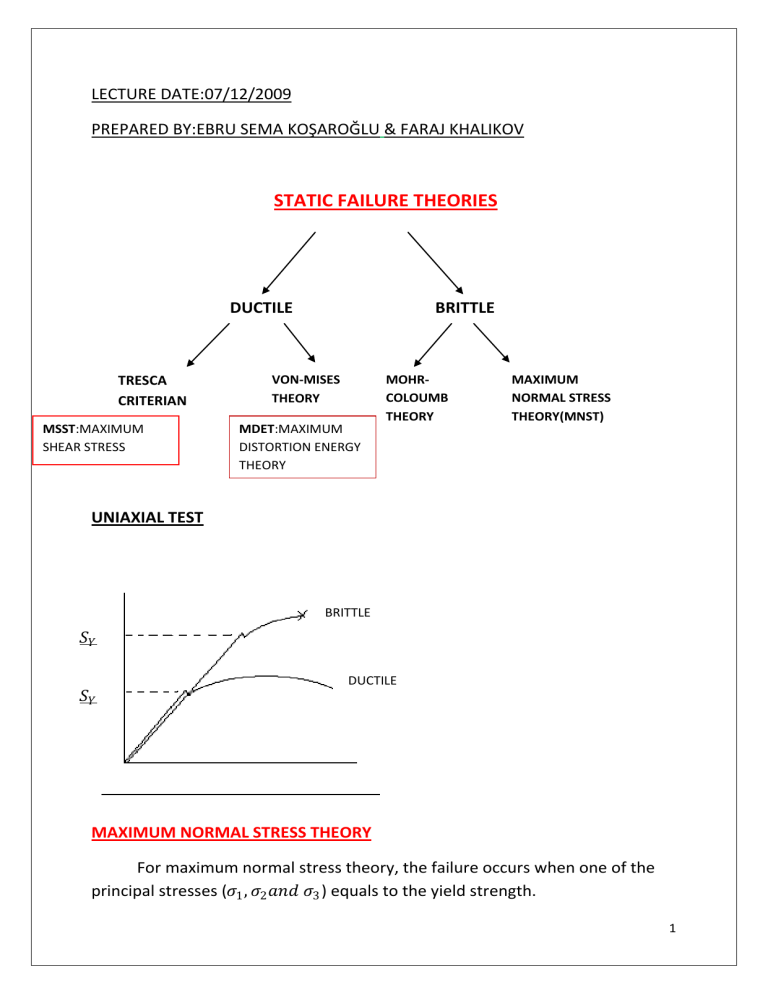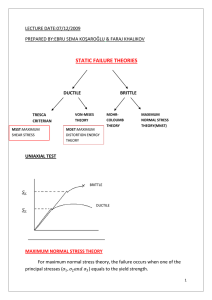Static Failure Theories: Lecture Notes on Ductile & Brittle Failure
advertisement

LECTURE DATE:07/12/2009 PREPARED BY:EBRU SEMA KOŞAROĞLU & FARAJ KHALIKOV STATIC FAILURE THEORIES DUCTILE TRESCA CRITERIAN MSST:MAXIMUM SHEAR STRESS THEORY BRITTLE VON-MISES THEORY MDET:MAXIMUM DISTORTION ENERGY THEORY MOHRCOLOUMB THEORY MAXIMUM NORMAL STRESS THEORY(MNST) UNIAXIAL TEST BRITTLE 𝑆𝑌 𝑆𝑌 DUCTILE MAXIMUM NORMAL STRESS THEORY For maximum normal stress theory, the failure occurs when one of the principal stresses (𝜎1 , 𝜎2 𝑎𝑛𝑑 𝜎3 ) equals to the yield strength. 1 𝜎1 > 𝜎2 > 𝜎3 Failure occurs when either 𝜎1 =𝑆𝑡 or 𝜎3 = −𝑆𝑐 ,where 𝑆𝑡 is strength in tension and 𝑆𝑐 is strenght in compression. MOHR-COULOMB THEORY The Coulomb-Mohr theory or internal friction theory assumes that the critical shearing stress is related to internal friction. MAXIMUM DISTORTION ENERGY THEORY(VON-MISES THEORY) The maximum distortion energy theory ,also known as the Von Mises theory, was proposed by M.T.Huber in 1904 and further developed by R.von Mises(1913).In this theory failure by yielding occurs when at any point in the body ,the distortion energy per unit volume in a state of combined stress becomes equal to that associated with yielding in a simple tension test. STRAIN ENERGY Generally strain energy U is obtained by this equation. U= 𝜀1 = 1 (𝜎 − 𝜈𝜎2 − 𝜈𝜎3 ) 𝐸 1 𝜀2 = 1 (−𝜈𝜎1 + 𝜎2 − 𝜈𝜎3 ) 𝐸 𝜀3 = 1 (−𝜈𝜎1 − 𝜈𝜎2 + 𝜎3 ) 𝐸 1 2 σij εij Then, substituting these three equations in to general strain energy equation: 1 1 1 1 2 𝐸 2 𝐸 U= 𝜎1 (𝜎1 − 𝜈𝜎2 − 𝜈𝜎3 )+ 𝜎2 1 1 2 𝐸 −𝜈𝜎1 + 𝜎2 − 𝜈𝜎3 + 𝜎3 (−𝜈𝜎1 − 𝜈𝜎2 + 𝜎3 ) HYDROSTATIC STRESS The hydrostatic stress(𝜎 )causes a change in the volume. 2 𝜎 = 𝜎1 + 𝜎2 + 𝜎3 3 Strain energy associated with the hydrostatic stress: 𝑈 = 1 3 (1 − 2𝜈) 2 [𝜎 2 + 𝜎 2 + 𝜎 2 − 2𝜈 𝜎 𝜎 + 𝜎 𝜎 + 𝜎 𝜎 = 𝜎 2𝐸 2 𝐸 Then distortional energy 𝑈𝑑 = 𝑈 − 𝑈 From previous equations: 𝑈𝑑 = 1+𝜈 3𝐸 𝜎1 2 + 𝜎2 2 + 𝜎3 2 − 𝜎1 𝜎2 − 𝜎2 𝜎3 − 𝜎3 𝜎1 Then yielding will occur at this condition: 𝑈𝑑 = 1+𝜈 𝑆 3𝐸 𝑌 𝜎𝑒𝑓𝑓 =𝑆𝑌 = 𝜎𝑒𝑓𝑓 = 𝜎1 2 + 𝜎2 2 + 𝜎3 2 − 𝜎1 𝜎2 − 𝜎2 𝜎3 − 𝜎3 𝜎1 (𝜎1 − 𝜎2 )2 + (𝜎2 −𝜎3 )2 + (𝜎3 − 𝜎1 )2 2 For plane stress condition 𝜎3 = 0 𝜎𝑒𝑓𝑓 = 𝜎1 2 + 𝜎2 2 + 𝜎1 𝜎2 If the state stress is in this area then the material will not yield. For pure shear condition 3 𝜎3 = −𝜎1 𝜎𝑒𝑓𝑓 = 𝜎1 2 + 𝜎3 2 − 𝜎1 𝜎3 = 3𝜎1 2 = 3𝜏𝑚𝑎𝑥 2 =𝑆𝑌 𝜏𝑚𝑎𝑥 = 0.577𝑆𝑌 MAXIMUM SHEAR STRESS THEORY The maximum shearing stress theory is an outgrowth of the experimental observation that a ductile material yields as a result of slip or shear along crystalline planes. Yielding begins whenever the maximum shear stress in a part equals to the maximum shear stress in a tension test specimen that beings to yield. 4 τmax = SYS = yield strength in shear = τmax = SY 2 σ 1 −σ 3 2 Then , 𝑆𝑌 = 𝜎1 − 𝜎3 Elasticity -brittle Materials 𝜎1 (𝜎𝑥 ) = 𝜏𝑚𝑎𝑥 = 𝑆𝑌 𝑁 where N is safety factor (MNST) -ductile (MSST) 𝜎1 −𝜎3 2 (MDET) = 𝜎1− 𝜎3 = 𝜎𝑒𝑓𝑓 = 𝑆𝑌𝑆 (yield strength in shear ) 𝑆𝑌 2 𝑆𝑌 𝑁 𝑆𝑌 𝑁 Strain Energy: 𝜎𝑖 𝜀𝑖 5 1 𝜎 𝜀 =𝑈 2 𝑖𝑗 𝑖𝑗 𝑆𝑌 −𝜎 𝑒𝑓𝑓 𝑁 Design Margin=M= 𝑆𝑌 EXAMPLE:A circular shaft of tensile strength 𝑆𝑌 =350 MPa is subjected to a combined state of loading defined by bending moment M=8 kN.m and torque T=24kN.m.Calculate the required shaft diameter d in order to achieve a factor of safety N=2.Use a) the maximum shearing stress theory(MSST-Tresca) b)the maximum distortion energy theory(MDET –Von Mises) 𝜏𝑥𝑦 𝜎𝑥 𝜏𝑥𝑦 𝜎𝑥 c= 𝑑 2 𝜎𝑥 = Then,𝜎𝑥 = 𝑀𝑐 𝐼 = 32𝑀 𝜋𝑑 3 𝑀𝑑 2𝐼 and 𝜏𝑥𝑦 = and 𝜏𝑥𝑦 = 𝑇𝑐 𝐽 = 𝑇𝑑 2𝐽 16𝑇 𝜋𝑑 3 We need to find principle stresses: 6 a) For maximum shearing stress theory 16 𝜎1,2 = (𝑀 ∓ 𝑀2 + 𝑇 2 ) 𝜋𝑑 3 𝑆 32 𝜎1 − 𝜎2 = 𝑌 = 𝜎𝑥 2 + 4𝜏𝑥𝑦 2 = 3 𝑀2 + 𝑇 2 𝑁 𝜋𝑑 Then, substituting the numerical values of M,T, 𝑆𝑌 and N: d=113.8mm b) For maximum distortion energy theory 𝜎𝑒𝑓𝑓 = 𝑆 (𝜎1 − 𝜎2) 2 + 𝜎1 2 + 𝜎2 2 = 𝜎𝑥 2 + 3𝜏𝑥𝑦 2 = 𝑌 = 16 𝑁 𝜋𝑑 3 4𝑀2 + 3𝑇 2 Then, substituting the numerical values of M,T, 𝑆𝑌 and N: d=109mm FRACTURE MODES OPENING SLIDING TEARING Fracture is defined as the separation of a part into two or more pieces.The mechanisms of brittle fracture are the concern of fracture mechanics ,which is based on a stress analysis in the vicinity of a crack or defect of unknown small radius in a part. 7 MULTIPLE FRACTURES P P Stress Intensity Factor: In the fracture mechanics approach a stress intensity factor,𝐾𝐼 , is evaluated. This can be thought of as a measure of the effective local stress at the crack root. 𝐾𝐼 = 𝛽𝜎 𝜋𝑎 8 where 𝜎=normalstress, 𝛽 = 𝑔𝑒𝑜𝑚𝑒𝑡𝑟𝑦 𝑓𝑎𝑐𝑡𝑜𝑟 𝑤𝑖𝑐 𝑑𝑒𝑝𝑒𝑛𝑑𝑠 𝑜𝑛 𝑎 𝑤 , 𝑎 = 𝑐𝑟𝑎𝑐𝑘 𝑙𝑒𝑛𝑔𝑡 (or half crack length) ,w=member width(or half width of member) Fracture Toughness: In a toughness test of a given material, the stress – intensity factor at which a crack will propagate is measured. This is the critical stress intensity factor , referred to as the fracture toughness and denoted by the symbol 𝐾𝐼𝐶 . 𝐾𝐼𝐶 N= 𝐾𝐼 (N=factor of safety) EXAMPLE: For a shape with width 12m , crack length 65mm , thickness 30mm and applied loading 50MPa.Find the factor of safety.( 𝐾𝐼𝐶 =28.3MPa 𝑚, 𝑆𝑌 =240MPa) 50MPa 65mm 30mm 240 𝑁1 = 50 12m = 4.8 From the ratio of a/w: 𝑎 65 × 10−3 = = 0.0054 𝑤 12 9 From table β≅ 1. 𝛽 = 𝐾𝐼 = 𝜎 𝜋𝑎=50 𝜋 65 2 𝐾𝐼 𝜎 𝜋𝑎 10−3 =15.97MPa 𝑚 𝐾𝐼𝐶 For safety factor: 𝑁2 = 𝐾𝐼 = 28.3 15.97 = 1.77 𝑁2 is better than 𝑁1 in order to obtain a safe structure; therefore, to have a safe structure, loading should not be used to calculate safety factor. 10 Reference List: 1. Lecture Notes AEE 361, Demirkan ÇÖKER), 2009, “Static Failure Theories” 2. Static Failure theories, Ansel C. UGURAL & Saul K. Fenster, 2007, “Advanced Strength and Applied Elasticity”, fourth edition. 3. Lecture 5 & 6, The University of Jenessee at Martin School of Engineering, 2009, “Machine Design Notes”. 4. Static Failure theories, J. Keith Nisbett, 2009, “Shigley’s Mechanical Engineering Design”, eighth edition. 11



